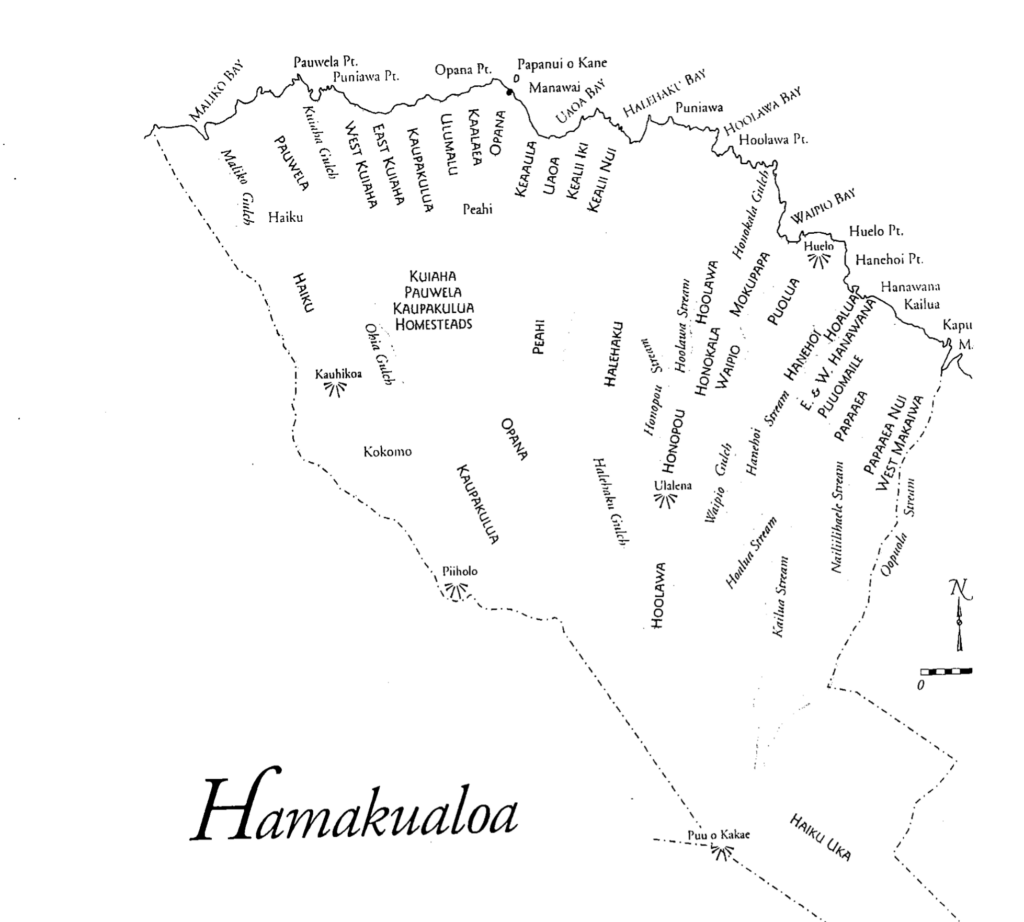
Protecting What We Love: Hāmākualoa, Our Shared Home
This post is from a series called Peʻahi Stories, a place- based literacy project launched in 2022.

“When I came here in the 1970s, I felt more welcome than any place in my life.”
“It’s upsetting to us, to see all that has changed and is gone now.”
“I try not to look. We stay home.”
These are the voices of our neighbors. Longtime Haʻikū and Huelo residents, they deeply care for Maui, especially the moku (land district) of Hāmākualoa, and feel some aspects of the place they have known slipping away. As I listen to their statements, I hear W.S. Merwin’s voice, too. He wrote in a gardening journal of his reluctance even to speak the name of the valley where he lived.
“This is Peahi. It is a name that I have known, and pronounced, to myself and others, fondly and with a sense of intimacy, rather as one would pronounce the name of one’s mother or of anyone close and closely held. A name with a life and privacy of its own. In recent years, very recent, I have come to use the name, except among friends, with a certain wariness because it has been scooped up and attached to a latter-day scheme to commodify the coast along to the north…”
From the beginning, this community storytelling—and story gathering—project has sparked dialogue among residents of Peʻahi, Halehaku, and other points close to The Merwin Conservancy. Starting with community conversations and a year-long interpretive planning process, this dialogue has guided our steps as we settled in as stewards of the Merwin’s former home in January 2020. We have learned from poignant and memorable conversations with community leaders, local historians, ʻAha Moku Council members; board members and volunteers at Mālama Hamakua Maui; members of Kalanikahua Hou Church, the Maui County Archaeologist; senior staff at Hawaiʻi Land Trust; and others who have been in the area for generations.
With a goal of deepening our own knowledge and sharing what we have come to understand through our ethnohistorical study, in 2022 we hosted informal gatherings, attended community gatherings, and pitched in on volunteer days. We have spent time learning from primary source documents and oral histories alike. We were gifted dozens of maps, and summaries of community meetings and public discourse about the land. We have sat together and hiked the land with more than a dozen neighbors and subject matter experts. We have shared some of their stories in this monthly blog series. Along the way, we have seen how the Merwin Conservancy can serve as a place for intimate community conversations about the essence of Hāmākualoa.
We have also realized how much we still donʻt know, how these deep connections to place are forged over time, as the place inhabits us. In these nine months, we’ve of course only scratched the surface of all there is to learn. We also recognize that for every person who came to talk story with us, there were ten others who were hesitant to share their stories and knowledge, and chose not to.
“Our makua and kūpuna may have reservations about sharing their most intimate memories.”
It wasnʻt easy to gather people together. We relied heavily on friends at the Haʻikū Community Association to help us. Some neighbors hold tightly to their personal stories about the places that are integral to their lives–and rightly so. We are grateful that their ʻike (knowledge) has enriched our own understanding and approach to stewardship of place, and we deeply respect the circle of trust into which we were invited. We will remain discerning with respect to which stories we, in turn, will share.
Such discernment is critical; in August 2020, a widely published guidebook revealed “secret” waterfalls, coastal hikes, and cultural landmarks, many of them on private property or tucked away areas previously known and frequented only by locals. The over-exposure of cherished places has devastated many in our region, and across the islands.
While reticence to reveal stories is well founded, so too is a fervent commitment among many in our community to share their intimate and historical knowledge broadly and persuasively. Their voices ring out on a range of critical issues related to development and change in our region. Examples abound both in the public record and in intimate conversations. We are inspired to learn from both as we continue to deepen our own literacy of place here in Hāmākualoa, with gratitude to all who have, over generations, called this place their home.
This program is made possible in part by funding from Hawaiʻi Council of the Humanities through the Sustaining the Humanities through the American Rescue Plan (SHARP) with funds from the National Endowment for the Humanities (NEH) and the federal American Rescue Plan (ARP) Act.Any views, findings, conclusions, or recommendations expressed in this series, do not necessarily represent those of the National Endowment for the Humanities.